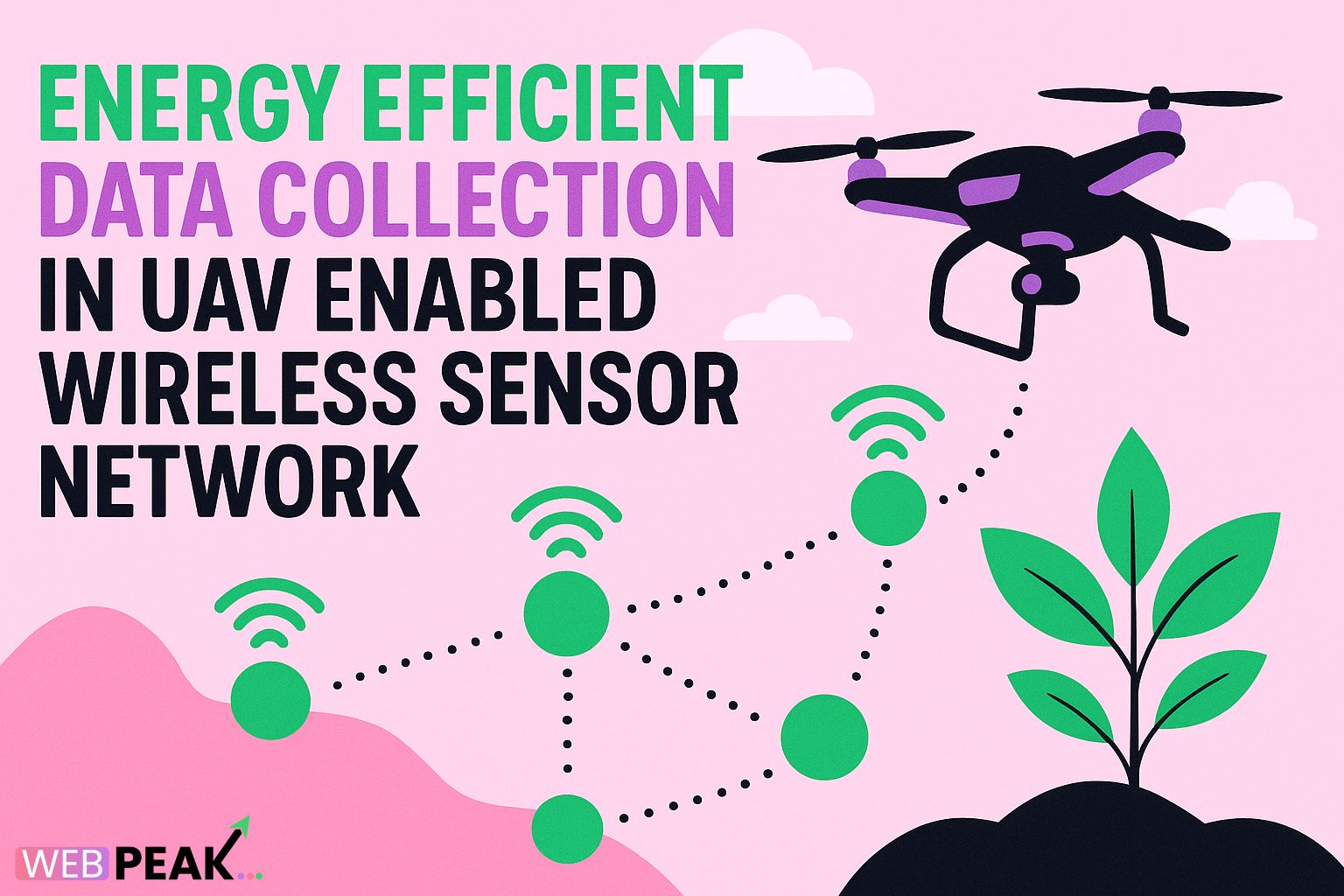Energy Efficient Data Collection in UAV Enabled Wireless Sensor Network
Energy efficient data collection in UAV enabled wireless sensor network systems has emerged as one of the most impactful advancements in modern IoT, communication, and smart automation technologies. As industries demand faster insights, longer sensor lifetimes, and scalable remote monitoring solutions, the combination of UAVs (Unmanned Aerial Vehicles) and WSNs (Wireless Sensor Networks) offers a powerful approach. UAVs can intelligently gather data, reduce energy consumption, and improve accessibility—especially in areas where traditional communication infrastructure is limited. Understanding how energy efficient techniques operate in UAV enabled wireless sensor networks is essential for engineers, researchers, and organizations building next-generation smart environments.
This in-depth guide explores the core principles, architectures, algorithms, deployment strategies, optimization techniques, benefits, applications, and challenges associated with energy efficient data collection using UAVs within wireless sensor networks. You will also find actionable SEO checklist points and a comprehensive FAQ section to support research, writing, and technical documentation.
What Is a UAV-Enabled Wireless Sensor Network?
A UAV-enabled wireless sensor network integrates traditional WSN nodes with unmanned aerial vehicles capable of flying over sensor-deployed fields to collect data, relay information, or recharge nodes. Unlike static base stations, UAVs provide mobility, flexibility, and controllability—allowing them to dynamically approach sensor nodes and optimize communication paths.
Key Components of UAV-WSN Architecture
- Sensor Nodes: Low-power distributed devices that collect environmental data.
- UAV Platform: A drone equipped with communication modules and sometimes onboard processing units.
- Ground Control Station: Operates or automates UAV movement.
- Communication Links: Wireless channels enabling data transfer between UAVs and sensor nodes.
- Power Sources: Batteries, solar panels, or energy-harvesting modules.
Why Energy Efficiency Matters in UAV-Enabled WSNs
Energy efficiency is a critical factor because both UAVs and sensor nodes operate with limited power. Sensor nodes must conserve battery life to maximize network longevity, while UAVs require optimized flight paths and communication workloads to avoid excessive energy consumption during missions.
Energy-efficient strategies directly impact:
- Network lifetime and node survivability
- Flight endurance and UAV operational capacity
- Cost savings in large-scale deployments
- Reliability and data accuracy
- Maintenance frequency and downtime
How UAVs Improve Energy Efficiency in WSN Data Collection
UAVs dramatically reduce energy consumption by minimizing the required transmission power of sensor nodes. Instead of sending data across long distances to a static base station, nodes transmit short-range signals to a nearby UAV, conserving battery life.
1. Minimizing Long-Distance Communication
Sensors traditionally consume most of their energy when transmitting data. UAVs reduce this load by approaching sensors directly, enabling short-hop communication.
2. Adaptive Mobility Patterns
UAVs can follow optimized trajectories to collect data while consuming minimal flight energy. Algorithms such as TSP-based path planning or reinforcement learning models guide UAV movement efficiently.
3. On-Demand Data Collection
Instead of sensors transmitting continuously, UAVs can collect data periodically or when triggered by events, drastically reducing unnecessary sensor communication.
4. Data Aggregation and Compression
Some advanced UAVs perform edge computing—processing and compressing data before transmission—reducing network load and energy consumption.
Techniques for Energy Efficient Data Collection
1. Optimized UAV Trajectory Planning
Trajectory optimization ensures minimal flight time and reduced energy consumption. Popular techniques include:
- Travelling Salesman Problem (TSP) for route optimization
- Genetic algorithms to find optimal sensor visitation sequences
- Machine learning-based adaptive paths for dynamic sensor conditions
- Circular or spiral trajectories for uniform coverage
2. Clustering-Based Data Aggregation
WSN nodes can be grouped into clusters, where cluster heads transmit data to UAVs. This minimizes network-wide communication load.
Common clustering protocols include:
- LEACH (Low Energy Adaptive Clustering Hierarchy)
- HEED (Hybrid Energy-Efficient Distributed Clustering)
- TEEN (Threshold-sensitive Energy Efficient Network)
3. Energy Harvesting Techniques
Modern WSN systems often integrate solar, thermal, or vibration-based energy harvesting, extending sensor lifetimes and reducing UAV workload.
4. UAV-Assisted Wireless Charging
Some advanced UAVs can wirelessly charge sensor nodes during flyovers using RF or inductive charging technologies. This technique greatly enhances sustainability.
5. Hybrid Communication Models
Energy efficiency improves when UAVs coordinate with satellite links, ground stations, or multi-UAV swarms, distributing workload across multiple platforms.
Applications of UAV-Enabled Energy Efficient WSNs
- Agriculture: Soil moisture monitoring, crop health detection, weather sensing
- Environmental Monitoring: Air pollution analysis, wildfire detection, forest humidity sensing
- Smart Cities: Traffic monitoring, infrastructure health sensing
- Disaster Management: Real-time monitoring of floods, earthquakes, landslides
- Military and Security: Border surveillance, intrusion detection systems
- Industrial IoT: Pipeline monitoring, hazardous material tracking
Challenges in Energy Efficient UAV-WSN Deployment
1. Limited UAV Battery Capacity
UAVs still face battery and payload constraints, requiring careful flight planning and energy-aware algorithms.
2. Weather Sensitivity
Wind, rain, and temperature variations can affect flight stability and energy usage.
3. Communication Interference
Signal attenuation and interference pose challenges in dense or remote regions.
4. Cost and Maintenance
Deploying and maintaining UAV fleets can be expensive for large-scale networks.
Emerging Trends and Future Directions
Technological innovations continue to shape the future of UAV-powered energy efficient WSNs. Some promising advancements include:
- Autonomous AI-driven UAV swarms for distributed data collection
- 5G-enabled drone communication for high-speed data transmission
- Lightweight solar-powered UAVs for extended missions
- Quantum communication-based WSNs enhancing security and reliability
- Digital twin modeling for virtual testing of UAV routes
Actionable SEO Checklist for This Topic
- Use the primary keyword "energy efficient data collection in UAV enabled wireless sensor network" in the title and H1.
- Insert the keyword in the introduction within the first 150 words.
- Add secondary keywords like "UAV trajectory optimization", "wireless sensor networks", and "energy-efficient WSN design" in subheadings.
- Include high-value long-tail keywords naturally within the content.
- Create structured headings (H2/H3) for readability and search optimization.
- Integrate an FAQ section with relevant questions users search online.
- Optimize for featured snippets by giving direct, concise definitions.
- Ensure paragraphs remain short, scannable, and rich in information.
- Add internal and external authoritative links as applicable.
- Use related semantic keywords such as IoT monitoring, drone data collection, and WSN optimization.
Frequently Asked Questions (FAQ)
1. What is a UAV-enabled wireless sensor network?
A UAV-enabled WSN integrates drones with sensor nodes to collect, relay, or process data more efficiently than traditional static base stations.
2. Why is energy efficiency important in UAV-WSN systems?
Energy efficiency ensures sensor longevity, optimized UAV flight time, reduced maintenance, and improved reliability of the entire network.
3. How do UAVs reduce energy consumption in wireless sensor networks?
UAVs reduce long-distance communication by flying near nodes, enabling short-range data transmission, which dramatically conserves sensor energy.
4. What algorithms are used for UAV path optimization?
Popular algorithms include genetic algorithms, TSP-based optimization, reinforcement learning models, and swarm intelligence algorithms.
5. Can UAVs recharge sensor nodes?
Yes, advanced UAV systems equipped with wireless charging technology can recharge ground sensors during flyovers, reducing downtime.
6. What industries benefit the most from UAV-enabled WSNs?
Agriculture, smart cities, environmental monitoring, disaster management, military security, and industrial IoT benefit significantly.
7. What are the main limitations of UAV-WSN systems?
Battery life, weather constraints, communication interference, and operational costs are the primary challenges.
Conclusion
Energy efficient data collection in UAV enabled wireless sensor network systems represents a transformative approach to modern sensing, automation, and IoT deployment. As technology evolves, UAVs will continue to drive innovation in data acquisition, environmental monitoring, and digital infrastructure optimization. For organizations investing in scalable and smart solutions, adopting energy-efficient UAV-WSN strategies is a vital step forward.
For businesses looking to build or optimize digital platforms related to IoT, AI, data systems, or UAV-based solutions, WEBPEAK provides full-service support in Web Development, Digital Marketing, and SEO to help projects scale effectively.





